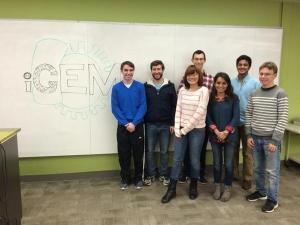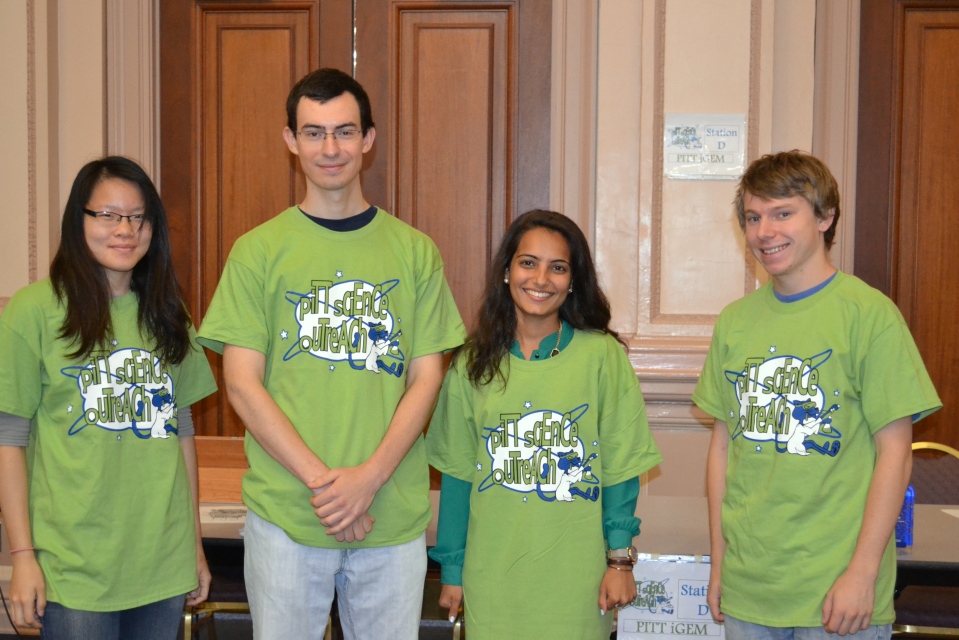Jamboree Results
Applying Scrum to iGEM
With the iGEM Jamboree fast approaching, iGEM teams across the world are frantically trying to remember their methods, find their results, and draw (fluff up) their conclusions. Amidst the flurry of tables and charts, a timeless question lingers: how the !%#@ did the summer go by so fast…?

But seriously, what happened to all that time? What about all the experiments we wanted to run? Where are all those results we still need?
Many tactics allow better use of the short time-span of a typical iGEM project, but they all boil down to three many strategies: working more efficiently, working more effectively, or some combination thereof. There is a big difference between efficiency and effectiveness, and successful teams know how to strike the right balance between the two. For example, an iGEM team who gathers tables on tables of data may be working efficiently, but what good is data if it doesn’t move the team any closer to the BioBrick parts they want to submit? For efficiency in the lab to count towards something, a solid plan must be in place to ensure the right data is collected. On the other hand, a rock-solid plan will set up an iGEM team for success at the start, but if they are struggling with simple reactions, then the plan is effectively useless. An efficient process must be in place for an effective plan to become reality. We will touch on effectiveness later, but for now this post is about improving efficiency. “Scrum Product Development,” or simply “Scrum,” is a very popular way of striking a balance between planning and working, so project tasks moving forward as fast as possible. Scrum is a methodology born and raised in the software industry, where people don’t really care about whether Google Search or Bing Search looks better on paper, they just want whichever one is faster.
The easiest way to start working more efficiently is often the most easily forgotten: start having more fun! Of course, finding ways to enjoy a day in the lab (without sunlight or food or water) is easier said than done, but you should never underestimate the power of a good list, and the little rushes of dopamine that come from checking things off. Now if you take your small checklist and put it on steroids for the whole lab to use, then you have the Scrum “Task Board.” On the Task Board, rows are organized into larger goals and smaller tasks are shuffled between “To-Do,” “In-Progress,” and “Done” columns. While a Task Board may seem like more work up front, there are several ways it will make your team more efficient. First and foremost, having documentation of experiments to be done holds everyone accountable for their work and vastly reduces the frequency of those embarrassing I-thought-I-told-you-to-do-[blank] conversations. Secondly, all progress throughout the week is highly visible, so less time is wasted for end-of-week experiments waiting to see if earlier experiments are finished or not. Thirdly, everyone will feel more empowered about their work when they can easily see how those hours slaving over a culture fit into the bigger picture.
Lastly, and most importantly, the Task Board is restricted to only the tasks within a one-/two-week window. More often than not, the results of this week’s experiments will dictate the experiments chosen three weeks from now, so don’t give yourself a headache from planning too far ahead. Instead of cluttering the Task Board with experiments that may or may not happen, another list (Product Backlog) is maintained to keep track of all the goals a team would like to get done at some point, but don’t need much detail, yet.

Most Scrum teams use a board with Post-Its, but a shared Microsoft Word document works, too. Just don’t forget to add color!
As Timothy Ferris of the Four Hour Work Week may attest, another easy way to improve efficiency is through delegation. However, within the context of Scrum, delegation takes a more nuanced definition. Here, delegating happens between the different phases of planning, where different types of team meetings are held with different goals and timelines to help prevent lab meeting from spiraling out of control. Why pull your hair out trying to cover every aspect of the project in a three-hour marathon meeting, when you could cover just as much ground by splitting up the discussion into two or three, thirty-minute meetings? Just like how companies cut down development time with Scrum, lab groups can publish faster using three, different key functions for meetings: short-term planning, mid-term planning, and long-term planning, with the option of short-term reflections to troubleshoot experiments/procedures.
Short-term planning meetings happen first thing every day so everyone can sync up and communicate their plan of attack on the Task Board. Also known as daily stand-ups, these meetings are quick (< 15 min), and allow team members to collaborate and plan for road bumps on the path ahead. Mid-term planning meetings happen every week to build up the Task Board and focus on the feasible amount of work to finish within a week. (Research teams can also adjust to two-week cycles if members are confident with troubleshooting experiments on their own.) Also known as sprint planning, these meetings are relatively short (< 30 min) and help keep the team focus on the necessary tasks to meet the goals currently on the Task Board, and nothing else. Especially with research, where untested hypotheses abound, it’s important to save big-picture goals for less regular, long-term planning meetings. Also known as product-backlog meetings, these meetings are longer (~ 45 min), and focus on all the blue-sky, iGEM-esque, shoot-for-the-moon discussions about where the project should head in the next couple months. A moderator is helpful for product-backlog meetings to keep discussion away from nitty-gritty experimental details, which are reserved for daily standups and sprint planning.

The daily standup is also known as the daily scrum. When deadlines are tight, the messy nature of scrum hails back to its rugby origins.
When you do math ([15 min * 7 days/wk] + [30 min * 1 day/wk] + [45 min * 1 day/wk]), the more shrewd of readers will comment on how the same amount of time is spent in meetings when following Scrum (3 hrs with Scrum vs 3 hrs without Scrum). And that’s the beauty of Scrum! No extra time is invested, but time is used far more efficiently, allowing the team to work faster where it counts, which is in the lab. Individuals are wasting far less time getting in each other’s way or figure out what to do next, and everyone feels more motivated because they can literally see the difference they are making in the Task Board.
There are far more principles of Scrum to apply in research, but for the time being, these two conventions go a long way towards improving efficiency. Using a Task Board and splitting up team meetings are simple, straightforward approaches cut out wasted time by keeping project goals crystal clear, all without overburdening teams or making anyone feel like a corporate manager.
For those interested in learning more about Scrum, see The Elements of Scrum by Chris Sims and Hillary Louise Johnson.
Skin Microbiome and Probiotics with AOBiome
Hello everyone! Today we have a Q&A session with Jasmina Aganovic, GM of Consumer Products at AOBiome, a Cambridge, MA based biotechnology company pioneering bacterial therapies for skin health (https://www.aobiome.com/). We are talking today about the skin microbiome and probiotics!
Q: What is the skin microbiome?
Pitt iGEM: The skin microbiome refers to the collection of bacteria that reside on human skin. Human adults house about 10^12 bacteria on our skin (1), all of which are necessary and vital to skin’s healthy function. They serve as physical barrier, preventing any harmful environmental factors from penetrating the skin. They also inform the immune cells present on the skin of harmful organisms, thereby eliciting the correct immune response (2).
AOBiome: Human skin harbors a fascinating array of species of bacteria, fungi, and other microorganisms. The specific makeup of the skin flora depends on many factors, such as whether the particular skin area is dry, moist, and sebaceous, etc. Dry forearms and hairy, moist underarms are very distinct habitats, despite their relative proximity. People living together also seem to share a larger portion of their microbiomes than those not cohabitating, and pet owners share some with their animal companions.
Q: What are skin probiotics?
Pitt iGEM: Probiotics are living bacteria that resemble the bacteria found in and around the body. Probiotics are generally thought to be beneficial to health and can be in oral or topical supplements (3). With regards to the skin, topical probiotics can restore the natural skin microbiome that is depleted with regular washing. This restoration also helps build the skin’s natural immune response to foreign invaders. Probiotics can also serve an antimicrobial role by killing unwanted bacteria.
Q: Who are the key players in skin probiotics?
AOBiome: Ammonia-Oxidizing Bacteria – This is a class of bacteria that is present virtually everywhere you find ammonia in nature. It is involved in the nitrogen cycle and works by consuming ammonia and producing Nitrite and Nitric Oxide (NO) as a byproduct. It’s presumed that our ancestors had this on their skin – a mutually beneficial working relationship. Ammonia Oxidizing bacteria in the natural environment helps regulate our nitrogen metabolism. Unfortunately, AOB on our bodies have been impaired by culture and other behaviors.
Q: What is the current state of the skin probiotic industry?
AOBiome: At AOBiome, we have isolated and patented a strain of Ammonia Oxidizing Bacteria called Nitrosomonas D23. This particular strain maximizes ammonia utilization by producing unique enzymes on elaborately folded cell membranes, thereby increasing both their ammonia-oxidizing capacity, and their energy output. This elaborate membrane architecture also renders Nitrosomonas particularly sensitive to membrane-disrupting chemicals such as anionic surfactants found in modern soaps and detergents.
We are developing the use of Ammonia Oxidizing Bacteria (AOB) as topical treatments to replenish the skin’s natural microbiome. Just as maintaining a healthy microbiome in the gut has been linked to various health benefits, we are focusing on the same applications to the largest organ in the human body – the skin. We believe restoring AOB to your skin helps it return to its natural harmony, leading to skin that looks and feels great.
Pitt iGEM: Stay tuned for a blog post debunking which products truly have probiotics and which don’t. Don’t fall for the marketing hype!
Q: What is the future of skin probiotics?
Pitt iGEM: In the US, 2 million people are infected with antibiotic-resistant bacteria annually, resulting in 23,000 deaths (4). Antibiotics are bad for the gut microbiome, and excessive antibiotic use can also chronically impair the skin microbiome. While antibiotics mitigate symptoms of acne, extended use can compromise the healthy diversity of skin flora, leading to inflammatory conditions such as dermatitis and rosacea.
Alternative therapies for acne are necessary to sequester antibiotic resistance. Building on our research, scientists can study of the natural role of skin bacteria and ultimately develop skin probiotics that address the cause of skin disorders, rather than just treating the symptoms.
AOBiome: Healthy skin microbiomes for everyone.
Our goal as a company is to help people get a healthy skin microbiome. We view this as a 2-part process and aim to develop a product line that reflects this:
- “Replenishment” – This involves the replenishing of beneficial bacterial (our AOBs) to the skin on a regular basis (because they will naturally fall off from basic activities). The products in this category will contain the live bacteria. Our AO+ Mist falls in this category.
- “Maintenance” – Ensuring that other products your skin does come into contact with are “biome-friendly” (will not harm the beneficial bacteria). We are yet to launch products in this category, but it will be critical in shaping the full picture.
Ultimately, we hope to create more of a dialogue around the biome as a crucial piece of formulation. To date, formulators focus on effectiveness and texture, but the piece missing which has only come to light recently, is this delicate ecosystem that we cannot see. Turns out that these little things matter a whole lot more than we’d expect.
It’s relevant to note here that outside of the consumer business, the other half of the company is focused on therapeutics. As a whole, we’re committed to studying the potential of AOB and will be conducting numerous cosmetic and FDA regulated condition-specific clinical research studies to understand where restoring AOB have health impacts. Our goal is to identify where they make the most difference and make them broadly available in the most effective form for as many people as possible. This is why we are committed to learning the true health impact of AOB and following the scientific and regulatory process to do this right. It will take a number of years of study looking at both topical and systemic impact of AOB to really understand where they fit in human health . Beyond each of our individual choices as a society, a lot science needs to be done by AOBiome and many more to help support with evidence this seeming obvious return to our prior environment we all need to be committed to open ended research that can teach us how to live well in the world.
Have you heard of the skin microbiome? Are you willing to use skin probiotics? Let us know in the comments!
(1) http://www.textbookofbacteriology.net/normalflora_3.html
(2) http://www.ncbi.nlm.nih.gov/pmc/articles/PMC3535073/
The Pitt iGEM Team – Part 1
The Pitt iGEM team has been diligently working for months to complete their iGEM project and achieve experimental successes. What drew the team to this project in the first place?
Watch our video to find out!
An Undergraduate Guide to Scientific Literature – Part 3
Welcome back everyone! Today we have the last two steps necessary for a successful literature search!
(Recall Step 1 is planning, and Step 2 is collecting.)
Step 3. Filtering
“The supreme art of war is to subdue the enemy without fighting.” – Sun Tzu
Once you feel satisfied about your pile of literature, start refining your folders down to only the most relevant papers. Discarding irrelevant papers at the front end will save hours of potentially wasted time trekking to Starbucks for yet another iced coffee. At this point, it is normal to feel frustrated about the lack of “real” work; you have not actually read any papers yet, but that is okay. Right now, you are saving your brain-power for the few, key papers that will serve as the basis for your future project. Sticking to a planning, collecting, and filtering stage will help prevent your attention from slipping as you move into the hardest phase, interpreting.
The vast majority of papers can be filtered by reading the first two and last two sentences of the abstract. Generally speaking, the first part of an abstract describes the purpose of the experiments, the middle part describes the experiments, themselves, and the last part of an abstract describes the most important conclusions. When filtering, avoid the enticing draw of the introduction, and just read enough of each abstract to make a save/discard decision, and then move on to the next one. If you are on the fence, use the last sentence of the introduction as a determining factor, or you can just put the paper in a “maybe later” folder. However, considering you have already procrastinated this much, the “maybe later” folder can very quickly turn into a “probably never” folder, so use your own discretion here.
As always, remember to write everything down. The process of filtering may show some holes in your original research question identified in the planning stage, and you may need to restructure your sub-questions accordingly. At the very least, jotting down a sentence or two in plain English about your saved papers will make restarting your search easier after the inevitable obligation to attend class for participation points.
Step 4. Interpreting
“Focus on the journey, not the destination. Joy is found not in finishing an activity, but in doing it.” – Greg Anderson
Without a doubt, the hardest part of any literature search is when you have to get comfy and actually figure out the answers to your (or your mentor’s) scientific ponderings. But there is a good reason why the hardest step is saved for last: you are prepared for the challenge now! Take a look back at your plan, and see the papers you need to read, not as an endless time-warp, but as a simple project with clear intermediate and end goals. Doesn’t look so hard anymore, now does it? Furthermore, there are a couple more tips and tricks to save time when interpreting papers.
First off, start treating the methods section like the event horizon of a black hole – once you are in, there is no escape. Unless you plan on repeating the methods yourself, or you need clarification on a figure, just read the introduction, skim the results, and move onto the discussion, focusing on the data and conclusions most important to your project. The 80-20 Rule is extremely relevant here, where 80% of the important information can be found in 20% of the paper. Pro tip: you can get the entire story of the paper just by the figures, which proves the scientific community as a whole never really grew out of the I-won’t-read-a-book-without-pictures phase. Every piece of scientific literature contains a wealth of information, but try and contain yourself only to the parts most relevant to your specific questions, identified during the planning stage.
Secondly, try and tackle everything in bursts to maximize your productivity. Take breaks in between planning your search, collecting papers, and filtering. Completing each phase in a separate sitting will prevent you from stalling, and give you a sense of satisfaction from making progress. In the same manner, you will retain more information by breaking your interpretation into smaller chunks. Read two or three papers to answer one of your sub-questions, then take a short break. If you keep plugging along, you will be finished before you know it!
Lastly, (hopefully you saw this one coming) remember to write everything down! Besides keeping you from falling asleep at your computer, writing/typing notes for each paper will give you something to reference later without having to read the paper all over again. In addition, you can avoid falling down the reference rabbit hole by making a note to look up a citation later. Remember, keep your collecting and interpreting stages separate, because working on one task is always more efficient than trying to do everything at once.
And that’s all there is to it! Hopefully you have a much more holistic view of literature searches at this point, which will help you budget your time accordingly. Experience has shown there are no two ways around literature searches, but making and executing a plan can make the entire process much less painful, and all the while giving you a deeper sense of satisfaction at the end.
Best of luck, and happy searching!
About the author: As an undergraduate, Stephen Kita has completed research projects in five distinct spheres of academia (cell biology, material science, computer vision, signal processing, and synthetic biology), and has done his fair share of literature searches.
An Undergraduate Guide to Scientific Literature – Part 2
Welcome back everyone! We are still talking about literature searches today, so read on for Part 2!
(Recall that Step 1 is Planning – details here)
Step 2. Collecting
“A journey of a thousand miles must begin with a single step.” – Lao Tzu
Once you have a handy plan for the journey ahead, you can now begin collecting equipment necessary for climbing the peaks of knowledge, which arise before you. Most importantly, staying focused on a designated collecting phase allows you to save and sort a wealth of information, without investing any more time than waiting for a sample to spin down in the centrifuge. And how many times when designing an experiment have you remembered a critical fact you read in some paper, which you forgot to download? It should be right here in my browser history, though, right? Wow, did I really spend THAT much time on Facebook…?
An Undergraduate Guide to Scientific Literature – Part 1
Whether you are a budding scientist or a well-seasoned expert, we can all relate to the time when our procrastination has failed to stave off the inevitable literature search. After rearranging your desk, burning through a season of Weeds, and maybe even filling in your lab notebook to feel (somewhat) productive, your Chipotle burrito bowl is now rapidly approaching an unsatisfying room-temperature condition, and the soft glow of an empty PubMed search box is lying in wait, ready to engulf your hopes of a quick and easy search.
The fact is scientific literature has always been and will always be difficult to read. Even tenured professors have been documented squirming in their chair when reading journals outside their domain of expertise. The cryptic language of academia is fuzzy, at best, but can be unintelligible at worst. When you are utterly lost, our friends over at Ph.D. Comics have some humorous interpretations, but even they can’t decipher why aliquots of tarophil induce rapid conjunctification in Type 2a Plasmoids. So, is it time to throw our laptop across the room? Or is there a less violent path to publishable enlightenment?
Luckily, there IS a better way! Presented below is Part 1 of an overall strategy for successfully completing any and all literature searches (your mileage may vary). With the help of this step-by-step guide, you can reduce the time and energy you spend finding the answers to your scientific questions. Understanding the ebb and flow of journal articles will help you move from one stage to the next without wasting time. You can then quickly return to the things you enjoy most, like stocking reagents, filling 96-well plates, and bothering your mentor.
SciencePalooza
On Thursday, July 31st, Pitt iGEM participated in SciencePalooza 2014! This event, hosted by the Clinical and Translational Science Institute at the University of Pittsburgh, is a day-long camp designed to show K-8 kids the value and excitement of science. The kids came from from underserved communities in the greater Pittsburgh area. Campers visited 8 different stations throughout the day, engaging in hands-on activities that present various scientific topics in a fun and engaging manner. The activities were designed to introduce science as a potential career interest, not just a boring school class.
Our team developed a module named “Dermalicious” to teach the children, primarily 4-6 grade, about the structure and proper care of their skin. After an interactive worksheet, the campers build a candy model, in which layers of the skin are represented by marshmallows, fruit sheets, and licorice. Take a look at one below!
After the module, we asked the kids to write down their thoughts of the activity:
“Your station was the funnest out of all of them.”
“I liked the creative and unique way of making a model of skin, especially with FOOD!”
“I liked it because it was creative and sweet”
“I liked this activity because we got to build the experiment”
“I think this station was a fun and informative lesson, it also makes me think about what’s under my skin”
Overall, the Pitt iGEM team had a great time at SciencePalooza teaching and engaging children with (delicious) science!
Welcome!
Hello Everyone!
We are the University of Pittsburgh’s first iGEM team and we are very excited to announce the launch of our crowdfunding campaign, Living Skin Therapeutics.
Throughout the course of our project, we will be blogging along with team member profiles, insider information, tips & tricks, and our overall iGEM experiences! So be sure to stay tuned as we have some exciting content in the works!
In the meantime, check out our:
—
Team DermGerms








